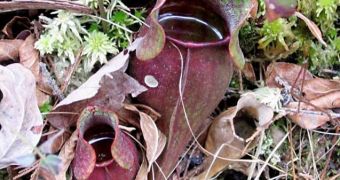Modeling nature and the interactions that take place within ecosystems is one of the most complex and demanding tasks that scientists working in this field of research have. Performing complex studies in nature to look at ecosystems is not always possible, because the methods would be either unethical (removing an animal from its habitat to see what happens), or impractical (accounting for all the interactions that occur within a rainforest). Now, experts seem to have found the best natural model possible, in the leaves of carnivorous plants.
Though this may seem a bit odd at first, it all makes sense when looking at the way their leaves are designed. They are deep and circular, and the hole is filled with water. Insects flying in the plant slip and fall in the “pond,” where they drown. The, they proceed towards feeding not only the plant itself, but also an intricate system of bacteria, plankton and invertebrates, which, by all definitions, constitutes an ecosystem. Additionally, each leaf has a different ecosystem than the other, which means that scientific data gathered from them are both conclusive and unique.
“Each leaf is its own individual lake, its own individual ecosystem. Suddenly, in a bog I can walk to from my office, I’ve got 50,000 lakes to do experiments on. This is an opportunity to understand how a complete, functioning natural ecosystem works,” says Harvard University biologist Aaron Ellison. Studying ecosystems is essential to science, as deciphering all interactions that occur within one could lead to better understanding it. Additionally, if something is to go wrong inside it, researchers would know where to start fixing it.
But perhaps the most important thing about this line of studies is the fact that it could finally provide a link between small-scale scientific lab studies and macroscale observations, such as those collected from decades of satellite investigation. The intermediary step is unknown, and the connection between small-scale event and large-scale events is still scarcely documented in many areas.
“Islands are beloved by ecologists, because they’re simplified fractions of the whole complex world. And one way to think about pitcher plants is as a modest-scale island,” says University of Florida ecologist Robert Holt, who has been tracking the pitcher plant work, Wired informs. “You’ve got four or five trophic levels in a pitcher plant, just like you’ve got four or five trophic levels in a lake,” Ellison concludes.

 14 DAY TRIAL //
14 DAY TRIAL //